By Michael Chibuzo
In recent times in Nigeria, the term ‘national grid’ has become part of our popular lexicons. It is common to hear a lot of people say, or even media organisations report that the “national grid has collapsed”. What immediately then comes to the mind of most people is that there is a national blackout. In those circumstances, “expert advices” from both the informed and uninformed would start flying around. Opposition politicians also try to cash in by bashing the government in power and indirectly saying that the situation would have been different if they were the ones in power instead.
After going through the commentary of people including those who ordinarily should be better informed on issues pertaining to the national grid and its collapses, I have found out that majority are really ignorant about what the national grid is all about in the first place, not to talk of its operation. Most people erroneously see national grid in Nigeria simply as the TCN network of the power sector. As a result of this ignorance (mostly innocent), I will attempt to explain what a national grid is, x-raying the complexities and challenges especially with Nigeria in focus.
What is an electric power grid?
In a simple language, an electric power grid is an interconnected network for electricity delivery from producers of the electricity (power generation plants) to the consumers of the electricity. In other words, a grid consists of power plants, transformers that step up voltage of electricity produced by the power plants for efficient transmission through transmission lines (high tension lines), electricity substations with transformers that step down voltage of electricity from the transmission lines, distribution substations that further step down voltage of the electricity before supplying to consumers.
So, in essence, the power grid is a network of power plants, transmission lines and distribution lines. It becomes a NATIONAL GRID if the network extends throughout a nation. If the network is restricted to a region, it is called regional grid. In Nigeria, we have the national grid because there is only one interconnection network that transfers electricity generated from different power stations to electricity consumers passing through the transmission and the distribution networks.
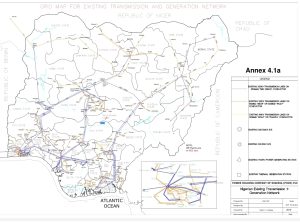
Why do we have a national grid in the first place?
To understand why an electricity grid is necessary, we would need to start by understanding how electricity is produced in the first place and also how it is transmitted from the point of generation to the electricity consumers.
Electricity is produced mostly through the use of a a turbine generator set, which converts mechanical energy to electrical energy. The turbine and the generator are two different devices, which carry out two different functions. The generator however needs the services of the turbine to produce electricity. A turbine is a rotor shaft with special blades attached to to it and is used to transform the energy of moving water, steam, combustion gases or wind into mechanical energy. The force of the fluid on the blades spins or rotates the rotor shaft of a generator. The generator, in turn, converts the mechanical (kinetic) energy of the rotor to electrical energy (electricity) at relatively low voltage (i.e. pressure or tension) of 11.5kV to 16kV. So, in the gas-powered power plants or the hydropower plants, the work of the gas or water respectively, is simply to force the blades of the turbine to rotate, which then turns the shaft of the generator – the electromagnetic device that generates electricity.
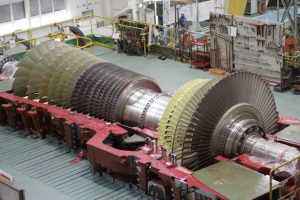
The electricity generated however, needs to be transmitted over long distances from the remote locations of the power plants to where electricity consumers are. However, before the electricity from the power generation plants is transmitted, the voltage (tension) is increased from the 11kV that was generated to a high voltage (tension) of 330kV using step-up transformers. This is carried out in the power substation located within the premises of the power plant. The movement of electricity from the turbine-generator unit of the power plant to the power substation in the same power plant housing the step-up transformers (usually 60MVA, 100MVA or 150MVA) is the point where power generation interface with transmission.
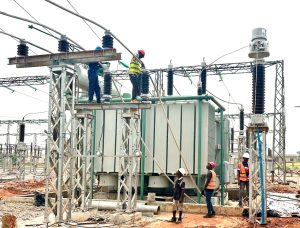
From the power substation within the power plant, the high voltage bulk electricity enters into the transmission network made up of very high towers constructed with steel to support an overhead power line (the popular high tension lines we see around). The transmission lines crisscross the entire length of the country (in Nigeria’s case) delivering 330kV electricity to the 330kV/132kV transmission substations scattered across the country. In Nigeria we have forty-eight (48) 330kV/132kV transmission substations.
The 330kV/132kV substations, just like the power substations in the various power plants, is also made up of transformers. However, this time around the transformers are step-down transformers, which step down the voltage of the bulk power from 330kV to 132kV. This voltage is still very high and is further transmitted to 132kV/33kV substations. At the 132kV/33kV transmission substations, the 132kV power from the main transmission feeder is further stepped down by transformers to a voltage of 33kV. It is at this point that the transmission segment of the grid links to the electricity distribution system.
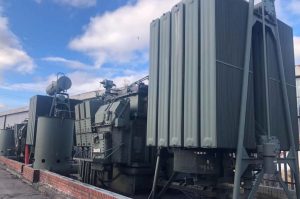
Electricity distribution substations collect power from the 132kV/33kV transmission substation with voltage at 33kV. At the distribution substations, 33kV to 11kV transformers step down the voltage to a safer level of 11kV (the same voltage produced by the power plants in the beginning). This 11kV power is distributed via 11kV feeders to residential and commercial areas. The 11kV lines are what feed the local transformers in the streets, which in turn distribute power to the buildings in the area. The 11kV step down local transformers are what step down the 11kV to the common 120V, 240V, or 400V that many electrical appliances can safely use without damaging the devices. This is the terminal point of the electricity grid. So, the electricity grid starts from the generation plants through the transmission lines and terminates at the distribution segment.
So, why does Nigeria has a national grid? It is quite simple. Nigeria has 28 major power plants (both thermal and hydro) with total installed capacity of 13,610MW. Out of this 28 plants, 23 are thermal plants located mostly in the Southern Nigeria and together account for 10,932MW or 80% of Nigeria’s total installed generation capacity. The remaining five plants are hydropower plants and account for 2678MW or 19.68% of our installed capacity. All the thermal power plants are in the South except for Geregu, which is in Kogi State while all the 4 major hydropower plants are in the North Central (Niger – 3; Kwara – 1) with the remaining one being the 40MW Dadin Kowa plant in Gombe state. The electricity generated by these plants, which are mostly sited in remote areas close to either gas resources (for thermal plants) or dams (for hydro plants) need to be evacuated to where electricity consumers are such as in cities, towns and villages.
The only way to achieve such a transfer of electricity is through the use of transmission lines that evacuate the high voltage power from the generating stations to substations nearer to the areas where the consumers are. From here, the distribution company in the area can then feed powers to homes and businesses. This is why we have a national grid connecting Gencos wherever they are located to Discos wherever they are located.
For example, power generated at the Kainji hydropower plant in Niger state is wheeled through 330kV transmission lines strewn on steel towers over a distance of 310km to the Birnin Kebbi 330kv/132kv transmission substation in Kebbi State. From this substation, the power is stepped down to a voltage of 132kV and travels another 130km from Birnin Kebbi before it gets to Sokoto metropolis where a 132kV/33kV transmission substation further steps the electricity down to a voltage of 33kV, which can then enter the distribution system of the Kaduna Disco.
So, between Kainji power substation (where the power is stepped up to 330kV) and the Sokoto 133kV/33kV (where power is stepped down back to 33kV), there is a distance of 440km. The transmission towers are spaced approximately 400 meters apart. This means that between Kainji and Sokoto there is at least 1,100 steel transmission towers. And any fault in any of these 1,100 towers, such as a snapped line between two towers, may interrupt power transmission from Kainji to Sokoto and the grid would be said to have collapsed.
Nigeria’s national grid at a glance:
Nigeria today has 28 power plants connected to the national grid with a combined installed capacity of 13,610MW. On the transmission side, the Transmission Company of Nigeria (TCN) currently has forty-eight (48) 330kv substations and one hundred and forty-nine (149) 132kV substations spread across the country. These 330kV substations are interconnected by at least 6,393.55km of 330kV lines using over 16,000 steel towers. The 132kV high voltage transmission lines on the other hand cover a total distance of over 7780km. Power from the 132kV lines run by TCN is wheeled to the distribution system through at least 840 33kV feeders spread across the eleven (11) power Distribution Companies (Discos). The TCN currently has the capacity to transmit 8500MW of electricity.

The TCN by virtue of being the intermediary that connects power plants to the 11 load centers (Discos) and also due to the fact that they handle the bulk transfer of power over large distances across the country, they are basically the entity running the national grid. To achieve this, TCN has a national control center at Osogbo where it can control and monitor the entire transmission network of Nigeria. It also has three other control centers located at Benin, Ikeja West and Shiroro, which help in monitoring grid operations in the 330kV and 132kV Transmission network under them. With the increase in 132kV Transmission Substations in the transmission network, plans are already underway for three additional Regional Control Centres at Alaoji (in Abia State), Gombe and Kano.
What leads to grid collapse?
The central term that is important to the stability of a grid is FREQUENCY. Frequency in this context refers to the number of cycles or repetitions of a particular phenomenon (e.g. rotation) per unit of time. It’s measured in Hertz (Hz). In rotating mechanical devices, such as power turbine, whose rotations lead to electricity generation, the rotational frequency is measured in terms of revolution per minute (rpm). 60 rpm is equivalent to 1 Hertz. All the power plants connected to the grid are meant to generate electricity at a particular frequency. Nigeria’s national grid is set to operate on a frequency level of 50Hz with the upper limit being 51.25Hz while the lower limit is 48.75Hz. In a lay man’s language, grid frequency measures the DEMAND and SUPPLY of electricity despatch to consumers from the power generating plants.
Generation and consumption of electricity MUST be balanced across the entire grid because energy is consumed as it is produced. The grid is connected in such a way that the TCN through its subsidiary, the System Operator (NESO), is at the middle of the network and monitors aggregate electricity demand from customers connected to the various Discos and tries to match the demands by directing Gencos on the amount of electricity to generate through the use of automatic generation control (AGC) system. In essence, this automatic generation control adjusts the power output of multiple generators at different power plants, in response to changes in the load (frequency). However, if these changes are significant and occurs suddenly, the grid will protect itself via several means including automatic shut down of a power plant or all the power plants connected to the grid. This is when you say there is a grid collapse (whether partial or total grid collapse).
For example, if a total of 4,456MW is being generated by the power plants and consumers of Discos are using the entire 4,456MW with no excess load, the grid frequency will show 50 Hz indicating that generation is equal to consumption. If 4,456MW of electricity is being generated at a point, and electricity demand is just 4,000MW, the grid frequency will increase from 50Hz to say 51Hz and the automatic generation control will direct Gencos to adjust power generation to 4,000MW to correspond with the demand. This returns the grid frequency to 50Hz.
A similar thing happens if load or demand from consumers exceeds electricity supply from the Gencos. For example, if load on the grid is 4,200MW while Gencos are only supplying 4,000MW, the grid frequency will drop to 49Hz. In this case, the automatic generation control will cause power plants to supply more power to balance the load and normalise the grid frequency. Apart from balancing the grid frequency through automatically directing the increase or reduction in power generations, the System Operator can also channel electricity from an area where for example, the Disco becomes unable to distribute power to its customers for whatever operational or commercial reason, to another area where there is an unmet demand for electricity. This way, it maintains a balance between energy demand and supply without increasing or reducing power generation per se but by redirecting supply. These are the activities TCN carry out in their national or regional control centers.
The grid can however, collapse if the demand for electricity rises or falls significantly within a very short notice that doesn’t give the System Operator (TCN) enough time to activate the demand and supply control measures that would have stabilised the grid. What happens in this case is that, due to the grid frequency going beyond the upper limit of 51.25Hz or below the lower limit of 48.75Hz, the power plants’ control system automatically shuts down the generators to avoid potential damage. After the grid collapses, the System Operator (TCN) within seconds or minutes usually order the start off of power plants again to restore the grid. It directs specific Gencos to resume power generation, which it supplies to certain Discos and gradually expand to others until the entire network is restored. Sometimes, some areas are not reconnected to the grid immediately especially if the initial fault came from the area.
From our experience in Nigeria, grid collapse is due to a combination of factors. One is unexpected breakdown of equipment in many transmission or distribution substations or vandalism of power installations, which significantly reduces electricity demand abruptly, causing imbalance and triggering grid collapse. A second factor has to do with the electricity tariff system in Nigeria, which is not yet market-driven except for Band A customers. This leads to Discos rejecting electricity supplied to them by the Gencos because they cannot generate enough revenue to pay for the power supplied to them. With inadequate revenue their ability to upgrade and expand the equipment in their distribution network to serve more customers is severely hampered.
Recently, many parts of the country especially in the North West, North East and parts of North Central were without power. This was due to a fault (snapping of cables) along the Ugwuaji-Apir transmission line between Ebonyi and Benue states, which is a distance of 157km. The fault was later traced to a tower at a remote swampy location in Benue State. As a result of this major incident, power could not be wheeled from the power stations in the Niger Delta (Afam and Alaoji) which principally supply power to the Makurdi 330kv substation as well as the 330kv substations in Jos, Gombe, Yola, Jalingo, Damaturu and Maiduguri. This cut across the North Central and North East.
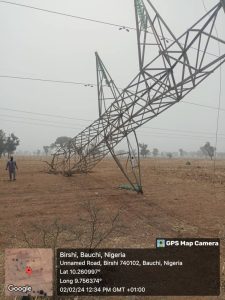
Ordinarily, because the grid is interconnected, even if the Ugwuaji-Apir transmission line was not supplying power to these areas mentioned from power stations in the Niger Delta, the Shiroro-Kaduna 330kV line could have supplied Shiroro power from the Kaduna 330kV substation to the Jos 330kV substation. Power is then supplied from Jos to Makurdi, Gombe, Yola, Jalingo, Damaturu and Maiduguri, limiting the area experiencing blackouts. Unfortunately, the Shiroro transmission line was vandalised at a point by bandits and only partially serving some areas along its axis of operation. Although efforts have been unrelenting to fix these faults, it however shows how vandalism can be a major headache for achieving grid stability.
Why national grid instead of regional or state grids?
Well, some would ask, why not decentralise the grid or encourage states to have their own grids or the private sector to invest in mini grids. The truth is that it is not that easy and requires a lot of calculations and considerations especially in the area of recouping investment. There are far greater benefits to derive from a national grid like ours than from a smaller grid especially when you consider our current peculiarities with electricity pricing. A national grid allows you to pool generation while leveraging on economy of scale, which results to lower generation costs. In Niger State for example, there are three hydropower plants (Kainji, Zungeru and Shiroro) with a total generation capacity of 2,060MW. Only Niger State cannot consume this amount of power currently. But if this volume of power is channeled to the national grid, it can supply any part of the country, especially areas where there is no power plant.
A national grid also allows you to pool load (electricity demands), which results in rechanneling of stranded power to areas with excess demand especially during peak periods. The only major disadvantage of a wide-area synchronous grid like ours is that problems in one part can have repercussions across the whole grid as we have experienced in the past couple of weeks. It is however important to note that Nigeria is not the only country with a wide-area grid. The lower 48 states in the US has three grids interconnected to each other. Each of the three regional grids in the US are larger than our national. In fact, the smallest among them, the Texas’ ERCOT supply electricity to Texas consumers with a generation capacity of more than 145,000MW and more than 84,812km of high voltage transmission lines and substations. By contrast, Nigeria has far less than that.
Addressing some of the challenges facing our national grid
Obsolete equipment at both the transmission and distribution levels are the major challenges affecting the stability of our national grid. The federal government, which owns the TCN has been enhancing the capacity of the transmission network through the Presidential Power Initiative (Siemens deal) and direct investment using TCN’s internal revenue. The FGN Power Company (the SPV for the Siemens deal) recently announced that the pilot phase of the Siemens deal is nearing completion.
This phase involves the deployment of 10 transformers and 10 mobile substations across various strategic locations in the transmission network. As at today, eight (8) power transformers have been successfully installed and commissioned in Ajah, Maryland, Apo, Okene, Ihovbor, Amukpe, Potiskum, and Birnin Kebbi. This upgrade has enhanced the transmission wheeling capacity of TCN by an additional 569.6 MW. Also, currently, 3 out of the 10 Siemens mobile substations are now operational in Ajah, Jebba, and Kawnar Dangora, contributing an extra 151.2 MW to the transmission capacity. The total transmission capacity currently is at over 8,500MW.
The equipment at the substations belonging to the Discos also need upgrade and expansion so that they can distribute more power to their customers. In this regard, the Tinubu administration has committed $800 million for the construction of new substations and distribution lines with Benin, Port Harcourt, and Enugu Discos allocated $400 million while Abuja, Kaduna, Jos, and Kano Discos gets the other half. These investments in the distribution infrastructure will reduce load rejection by this Discos and increase their ability to off take power, invariably enhancing the stability of the national grid.
With the Presidential Metering Initiative, more electricity consumers would be metered, enhancing revenue generation across the electricity value chain. This will encourage investors including states to begin to think about investing in intra-state grids that would still have some form of interface with the national grid. When we get to this point, grid collapses would be rare occurrences.

